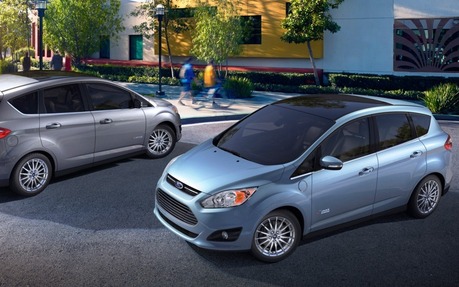Ford overstated fuel economy on C Max hybrid, will change window stickers to correct estimate
DETROIT - The U.S. government may change the rules for the gas mileage estimates that car buyers see on window stickers after finding that fuel economy figures for Ford's C-Max gas-electric hybrid were inflated.
The Environmental Protection Agency, which monitors mileage testing, said Thursday that it will cut the C-Max's combined city-highway mileage estimate by nearly 9 percent to 43 mpg, from 47. Ford Motor Co. will change its window stickers to reflect the correct estimate and said that it will compensate drivers for the difference.
C-Max buyers will get a $550 check, while those who leased will receive $325. The checks will be sent soon, the company said.
Ford followed EPA test procedures in calculating the mileage and did nothing wrong, said Christopher Grundler, the agency's director of transportation and air quality. The problem stemmed from agency guidelines that allow automakers to test one vehicle, then use its mileage estimates for other car models that have the same engines, transmissions and weight classifications, he said.
However, the EPA discovered that a test on one model may not be accurate for another because cars are getting increasingly more fuel-efficient. The agency may change its guidelines, as a result.
The Ford case is the second in less than a year where an automaker has cut mileage estimates after an EPA investigation. In November, the EPA found inflated numbers on 13 Hyundai and Kia models, affecting 900,000 vehicles.
Automakers follow EPA guidelines to do their own mileage tests, which are monitored by the agency. Experts say the Ford and Hyundai-Kia cases are signs that the EPA is getting more aggressive in verifying those tests.
The EPA began investigating the C-Max earlier this year after getting complaints from customers that actual mileage fell short of estimates. The initial estimates were high, Grundler said, because Ford tested the Fusion midsize hybrid, which has the same power system, and applied its mileage to the C-Max, he said.
However, the C-Max sits more upright and has different wheels and tires, so it doesn't slice through the wind as well as the Fusion, Grundler said. That caused the C-Max to show lower mileage when tested on its own, he said.
In the past, similar vehicles powered by gas engines got similar mileage, so using one test for a family of vehicles worked well, Grundler said. But the single test doesn't work for more efficient models like hybrids, he said. Hybrids get better mileage than gas engines by using a combination of electric and gas motors.
“These differences are more pronounced when you have a vehicle that uses so little fuel,'' he said.
Ford product development chief Raj Nair said the company is adding new seals around the C-Max's hood and new deflectors around its tires and lift gate to cut wind resistance and raise gas mileage.
Ford has no plans to change mileage labels on any other hybrids, he said.
The EPA may revise regulations for tests of similar vehicles because automakers increasingly are introducing more efficient power systems in the same cars across the globe, he said. The current regulations were developed in 1977, and the EPA is asking for input before making changes.
The EPA's tests still measure gas mileage accurately, but the agency is studying them to make sure they keep up with fast-changing technology, Grundler said, adding that tests during the past six months show the window labels are accurate. "Most people are getting the label values,'' he said.
Ford's Nair said a test that measures the amount of gasoline used per mile, instead of one that shows the number of miles a car can travel on a gallon, might be more accurate. The EPA has been receptive to the idea, he said.
The C-Max, which starts at $25,200, went on sale in October 2012. Through July of this year, the company had sold a total of 36,349.
In the Hyundai-Kia case, the automakers acknowledged the problem, changed the numbers and blamed a procedural error. As compensation, the companies have paid owners around $88 annually. The EPA is still investigating the case and may penalize the companies further.
The EPA has said the Hyundai-Kia case was the first in which erroneous test results were found in so many models. Until the C-Max, only two similar problems had been discovered since 2000, and those involved single models.
